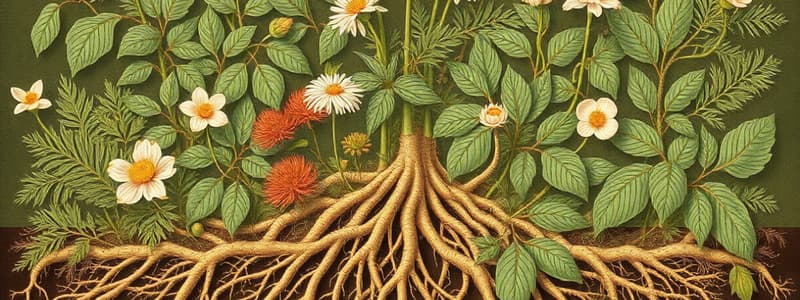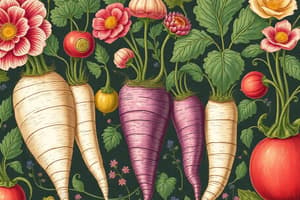Podcast
Questions and Answers
What is the primary function of the stem in a plant?
What is the primary function of the stem in a plant?
- To generate seeds
- To perform photosynthesis
- To provide support and hold the plant upright (correct)
- To absorb nutrients from the soil
Axillary buds are responsible for the primary growth of the entire plant.
Axillary buds are responsible for the primary growth of the entire plant.
False (B)
What is the portion of the stem between two nodes called?
What is the portion of the stem between two nodes called?
internode
The type of root that provides extra support in plants such as the banyan tree is called __________.
The type of root that provides extra support in plants such as the banyan tree is called __________.
Match the following types of roots with their functions:
Match the following types of roots with their functions:
Which part of the stem is primarily responsible for the growth at the tip?
Which part of the stem is primarily responsible for the growth at the tip?
Stilt roots grow from the upper part of the stem.
Stilt roots grow from the upper part of the stem.
Name one plant that has modified roots for food storage.
Name one plant that has modified roots for food storage.
What type of root system does a carrot have?
What type of root system does a carrot have?
Climbers can stand erect without support.
Climbers can stand erect without support.
Name two examples of herbs.
Name two examples of herbs.
The ______ is the part of the plant that grows above the ground.
The ______ is the part of the plant that grows above the ground.
Match the following plant parts with their functions:
Match the following plant parts with their functions:
Which of the following plants has a fibrous root system?
Which of the following plants has a fibrous root system?
Trees typically have many branches that grow from the lower parts of the trunk.
Trees typically have many branches that grow from the lower parts of the trunk.
What is the main part of the shoot system?
What is the main part of the shoot system?
What type of modified stem is a potato classified as?
What type of modified stem is a potato classified as?
The primary function of tendrils in climbers is to attract pollinators.
The primary function of tendrils in climbers is to attract pollinators.
Name one plant that has thorns for protection.
Name one plant that has thorns for protection.
Which of the following plants exhibits parallel venation?
Which of the following plants exhibits parallel venation?
The ________ is the part of the leaf that conducts photosynthesis.
The ________ is the part of the leaf that conducts photosynthesis.
Which type of venation is characterized by veins arranged like nets on both sides of the midrib?
Which type of venation is characterized by veins arranged like nets on both sides of the midrib?
Leaves have stomata on their upper side.
Leaves have stomata on their upper side.
Match the following types of modified stems with their examples:
Match the following types of modified stems with their examples:
What is the main function of stomata in leaves?
What is the main function of stomata in leaves?
Cacti have modified stems that store water.
Cacti have modified stems that store water.
Leaves modified into sharp structures are known as __________.
Leaves modified into sharp structures are known as __________.
The small stalk that attaches leaves to the stem is called the ________.
The small stalk that attaches leaves to the stem is called the ________.
What process do leaves use to prepare food for the plant?
What process do leaves use to prepare food for the plant?
What are carnivorous plants known for?
What are carnivorous plants known for?
Flowers are the reproductive organs of non-flowering plants.
Flowers are the reproductive organs of non-flowering plants.
What is the main function of petals in a flower?
What is the main function of petals in a flower?
Self-pollination occurs when pollen from one plant falls on the stigma of another plant.
Self-pollination occurs when pollen from one plant falls on the stigma of another plant.
What structure in a flower contains the ovules?
What structure in a flower contains the ovules?
The sticky substance that holds onto pollen grains during pollination is found in the ______.
The sticky substance that holds onto pollen grains during pollination is found in the ______.
Which of the following is a pollinating agent?
Which of the following is a pollinating agent?
Cross-pollination is facilitated only by wind and water.
Cross-pollination is facilitated only by wind and water.
After pollination, the size of the ______ increases and changes into the fruit.
After pollination, the size of the ______ increases and changes into the fruit.
Flashcards
What are trees?
What are trees?
Tall plants with a thick stem called a trunk, which supports many branches.
What are shrubs?
What are shrubs?
Short plants with a hard, brown stem and many branches. They live for many years.
What are creepers?
What are creepers?
Plants with very weak stems that grow along the ground.
What are climbers?
What are climbers?
Signup and view all the flashcards
What are herbs?
What are herbs?
Signup and view all the flashcards
What is a taproot?
What is a taproot?
Signup and view all the flashcards
What is a fibrous root system?
What is a fibrous root system?
Signup and view all the flashcards
What is the shoot system?
What is the shoot system?
Signup and view all the flashcards
What is the stem of a plant?
What is the stem of a plant?
Signup and view all the flashcards
What is a node?
What is a node?
Signup and view all the flashcards
What is an internode?
What is an internode?
Signup and view all the flashcards
What is an apical bud?
What is an apical bud?
Signup and view all the flashcards
What is an axillary bud?
What is an axillary bud?
Signup and view all the flashcards
What are prop roots or aerial roots?
What are prop roots or aerial roots?
Signup and view all the flashcards
What are stilt roots?
What are stilt roots?
Signup and view all the flashcards
What are breathing roots or pneumatophores?
What are breathing roots or pneumatophores?
Signup and view all the flashcards
Parasitic Roots
Parasitic Roots
Signup and view all the flashcards
Food Storage Stems
Food Storage Stems
Signup and view all the flashcards
Tubers
Tubers
Signup and view all the flashcards
Rhizomes
Rhizomes
Signup and view all the flashcards
Bulbs
Bulbs
Signup and view all the flashcards
Stem Tendrils
Stem Tendrils
Signup and view all the flashcards
Water Storage Stems
Water Storage Stems
Signup and view all the flashcards
Photosynthetic Stems
Photosynthetic Stems
Signup and view all the flashcards
Parallel Venation
Parallel Venation
Signup and view all the flashcards
Photosynthesis
Photosynthesis
Signup and view all the flashcards
Stomata
Stomata
Signup and view all the flashcards
Transpiration
Transpiration
Signup and view all the flashcards
Leaf Tendrils
Leaf Tendrils
Signup and view all the flashcards
Spines
Spines
Signup and view all the flashcards
Pitcher Plants
Pitcher Plants
Signup and view all the flashcards
Insectivorous Plants
Insectivorous Plants
Signup and view all the flashcards
Pollination
Pollination
Signup and view all the flashcards
Pistil
Pistil
Signup and view all the flashcards
Sepal
Sepal
Signup and view all the flashcards
Ovary
Ovary
Signup and view all the flashcards
Self-pollination
Self-pollination
Signup and view all the flashcards
Cross- pollination
Cross- pollination
Signup and view all the flashcards
Pericarp
Pericarp
Signup and view all the flashcards
Fruit development
Fruit development
Signup and view all the flashcards
Study Notes
Plants Around Us
- Plants are grouped by stem type: trees, shrubs, herbs, creepers, and climbers
- Trees are tall with thick trunks and many branches. They live for many years. Examples include Banyan, mango, and coconut
- Climbers have weak stems and need support to stand. Examples include grapevine, money plant, and pea
- Shrubs have hard, woody stems with small branches and live for several years. Examples include hibiscus, rose, and jasmine
- Creepers have very weak stems and grow along the ground. Examples include pumpkin and watermelon
- Herbs are small plants with soft, short stems and live for a few months. Examples include grass, coriander, mint, rice, wheat, and spinach
Parts of a Plant: Root System
- The root system is the part of the plant below the ground
- Two types of root systems: taproot and fibrous
- Taproot system has one main root with smaller branches. Examples include neem, mango, pea, carrot, radish, turnip, and mustard
- Fibrous root system has a cluster of thin roots. Examples include maize, wheat, sugarcane, rice, and grass
- Roots hold the plant in place, absorb water and nutrients, and prevent soil erosion
Parts of a Plant: Modifications of Roots
- Roots can be modified for different functions, including food storage
- Roots may become fleshy to store food(e.g., carrot, beetroot, radish, turnip, sweet potato)
- Prop roots support the plant, like in banyan trees
- Stilt roots support the plant base, like in maize, sugarcane, coconut
- Breathing roots (pneumatophores) help plants in wet, salty areas get oxygen. Examples: mangrove plants
- Climbing roots help plants climb, like in betel, black pepper, and money plant
- Parasitic roots get nutrients from other plants like dodder
Parts of a Plant: Stem
- The stem connects the roots to the rest of the plant, supporting it and transporting nutrients
- Stems have nodes (where leaves, branches, or buds grow) and internodes (the space between nodes).
- The apical bud is at the tip of the stem and responsible for growth, while axillary buds (at the nodes) grow into leaves, stems, or additional buds
Parts of a Plant: Modifications of Stems
- Stems can be modified for food storage like in ginger, potato, onion
- Stems can be modified into tendrils to support climbing plants (e.g., grapevine, cucumber)
Parts of a Plant: Leaves
- Leaves come in different shapes and colours and are responsible for food production (photosynthesis)
- Leaves have veins for support and transport of water, minerals and food
- Two main types of leaf venation: reticulate (net-like) and parallel (parallel lines)
- Leaves can be modified for water storage, food manufacture (cactus-like), and protection (thorns)
Parts of a Plant: Functions of Leaves
- Leaves produce food through photosynthesis
- Leaves absorb gases (carbon dioxide, oxygen) through stomata
- Leaves lose water through transpiration
Parts of a Plant: Flowers
- Flowers are the colourful and fragrant reproductive parts of plants
- A flower has male parts (stamens) – filament and anther, and female parts (pistil) – stigma, style, and ovary
- Petal- bright colored part of the flower that attracts insects for pollination with scents and colors
- Sepals and pedicel
- Thalamus
- Structure of a flower
Parts of a Plant: Pollination
- Pollination is the transfer of pollen from the anther to the stigma of a flower
- Flowers are helped by pollinating agents like insects, birds, wind, and water
- Two types of pollination: self-pollination (pollen to the same or other flower on the same plant) and cross-pollination (pollen to a different plant)
Studying That Suits You
Use AI to generate personalized quizzes and flashcards to suit your learning preferences.
Related Documents
Description
Explore the fascinating world of plants with this quiz focused on their classifications and root systems. Learn about the different types of plants, such as trees, shrubs, herbs, creepers, and climbers, as well as the characteristics of their root systems. Test your knowledge and discover more about the green wonders around us.




